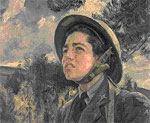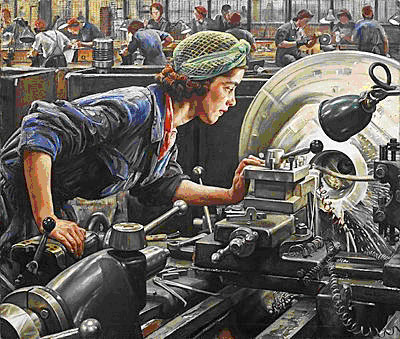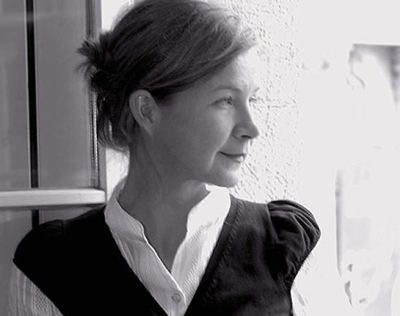Witness: Women War Artists
The first exhibition exploring the work of women war artists to be staged by the Imperial War Museum for 50 years is now on show at Daniel Liebeskind's new building in Manchester



Ruby Loftus screwing a Breech-ring, 1943, Dame Laura Knight RA. Oil on canvas. Ruby Loftus was something of a celebrity during the Second World War, having mastered a skill in a matter of months that usually took a factory worker several years. As well as being an iconic image of female accomplishment, this image was used heavily to promote female involvement on the home front.
Witness: Women War Artists is the third in the Witness series – which revolve around first person experiences of subjects – to take place at the Imperial War Museum’s sister gallery, Imperial War Museum North. It’s located in Daniel Liebeskind’s specially commissioned building in Manchester.

German photographer Frauke Eigen, whose Kosovo series is a recent addition to the Imperial War Museum's collection.
The show is the first time in 50 years that the Imperial War Museum has held an exhibition devoted to female war artists. The works cover the period from the First World War right up until the conflicts in Kosovo and Iraq and draw on its own collection. It should be said that from the beginning the aim of the exhibition is to raise the profile of these artists, rather than to make a case for the challenges they faced as female war artists. Frontline warfare, especially the muddy, bloody, unrelenting warfare of the First and Second World Wars, is, unsurprisingly, male-dominated. There are reasons that the output of official women war artists from the first half of the twentieth century is both less than that of their male counterparts, and narrower in scope.
That said, the curators of this exhibition have taken some delight in blowing apart one or two myths. The show opens up with a section titled ‘In Action’ for example, which features a series of works by female artists with direct experience of working on the front line. Here are the stark and apocalyptic works by Olive Mudie-Cooke, who, having been deployed to France in 1916 with the First Aid Nursing Yeomanry, was commissioned to produce a body of work in 1919 by the Imperial War Museum’s Women’s Work Sub-Committee, which had been set up in order to produce a record of the important work done by women during the First World War. The section also features the sketches of the 1982 Falklands conflict by Linda Kitson, who was the first female artist to be embedded with the army while it was deployed on active service.
There are also one or two well-known figures here who, like their male counterparts, were pioneers of their profession. The most notable example is Dame Laura Knight, who was already a fully-established artist in her own right by 1938, having become the first female artist to be elected as a Royal Academician for over 160 years. As well as her iconic portraits of war heroines, such as Ruby Loftus and Corporal Daphne Pearson, whose images were commissioned in part to encourage women into the war effort, the curators have also included her unusual and poignant1946 depiction of the Nuremberg trial.
Surrealist artist Paule Vezelay also worked for a time as a war artist in Bristol, though only after something of a struggle. ‘My work is very modern, even in Paris. Is the committee so reactionary at the Central Institute that it is displeasing to them?’ she wrote in 1941 in a letter to the War Artists Advisory Committee. ‘Nevertheless, while the modern weapons and inventions are needed to win the war, it would seem most suitable that the most modern artists are most likely to record it in a fitting manner.’
Sign up for the Country Life Newsletter
Exquisite houses, the beauty of Nature, and how to get the most from your life, straight to your inbox.
In the latter years of the 20th century, the museum committee responsible for commissioning war artists was resurrected, though the decision was taken to move away from purely archival material to more avant garde, reactionary art works . A fairly recent addition to the collection is Frauke Eigen’s Frundstücke Kosovo 2000 series, which is included within the section called ‘Parting and Loss’. Taking the form of single, enlarged photographs of half-decayed clothes removed for identification purposes from bodies from a mass grave in Kosovo, the stark images of the clothes, rather than a documentary-style photograph of the bodies themselves, is a haunting evocation of the individuals to whom they once belonged.
Interest in the exhibition therefore lies in its charting of the changing fortunes of women working in this select genre, but, as Eigen’s work demonstrates, the female viewpoint can lend an added dimension to an artwork, and the show should also be celebrated for its portrayal of key events in the 20th century through the eyes of the women who experienced it. Paintings documenting the work of the Women’s Land Army by Evelyn Dunbar for example, or the sketches and watercolours of life working in an aircraft components factory, done in secret by Margaret Abbess (permits were required for war artists, and anything remotely sensitive was officially out of bounds). As Olive Edis, a photographer working in the First World War, explained to an official censor of art and photography ‘the Imperial War Museum thought that a woman photographer, living among the girls in their camp, was likely to achieve more intimate pictures, more descriptive of their everyday life, than a man press photographer.’
Witness: Women War Artists. Imperial War Museum North until 19th April 2009. The Quays, Trafford Wharf Road, Manchester, M17 1TZ www.iwm.org.uk 0161 836 4000
Country Life is unlike any other magazine: the only glossy weekly on the newsstand and the only magazine that has been guest-edited by HRH The King not once, but twice. It is a celebration of modern rural life and all its diverse joys and pleasures — that was first published in Queen Victoria's Diamond Jubilee year. Our eclectic mixture of witty and informative content — from the most up-to-date property news and commentary and a coveted glimpse inside some of the UK's best houses and gardens, to gardening, the arts and interior design, written by experts in their field — still cannot be found in print or online, anywhere else.
-
 Designer's Room: A solid oak French kitchen that's been cleverly engineered to last
Designer's Room: A solid oak French kitchen that's been cleverly engineered to lastKitchen and joinery specialist Artichoke had several clever tricks to deal with the fact that natural wood expands and contracts.
By Amelia Thorpe
-
 Chocolate eggs, bunnies and the Resurrection: Country Life Quiz of the Day, April 18, 2025
Chocolate eggs, bunnies and the Resurrection: Country Life Quiz of the Day, April 18, 2025Friday's quiz is an Easter special.
By James Fisher